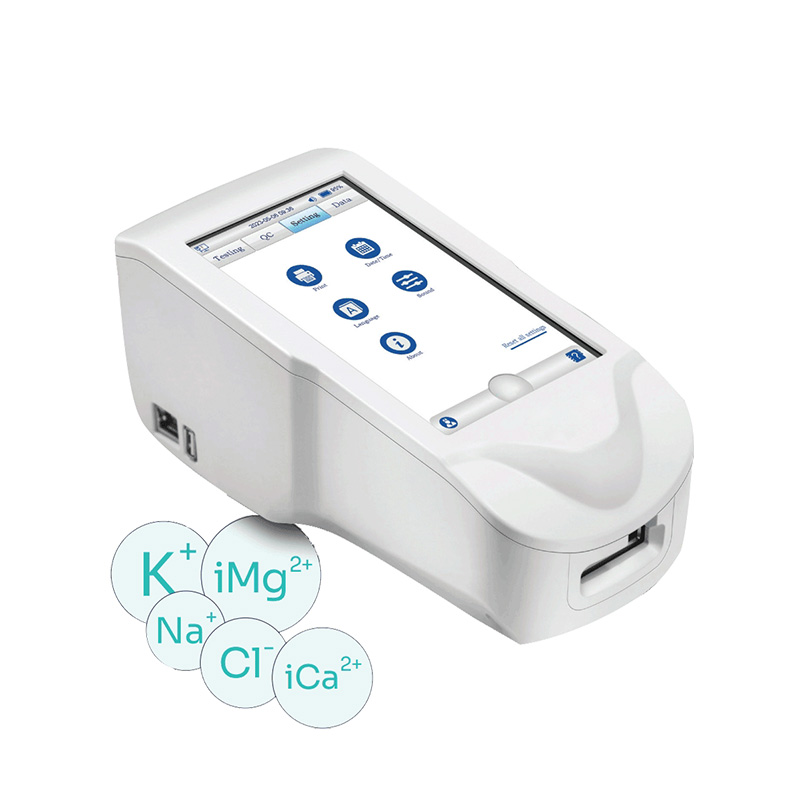Key Features and Benefits:
- Quality and Safety: FDA-approved and CE-marked.
- Technology: Uses Direct ISE for unparalleled accuracy.
- Electrodes: Long-life, maintenance-free.
- Modes: Automatic calibration and standby modes.
- Design: Compact, ideal for medium/high workload labs and hospitals.
- Cost-Efficiency: Economical price point.
- Performance: Offers excellent precision and reliability.
- Interface: User-friendly.
- Maintenance: Minimizes manual intervention and downtime.
- Construction: Durable materials and build.
Available Models:
- EM-3000AT: Measures K+, Na+
- EM-3000BT: Measures K+, Na+, Cl-, CO2
- EM-3000CT: Measures K+, Na+, Cl-, Ca2+, pH
- EM-3000DT: Measures K+, Na+, Cl-, Ca2+, pH, CO2
- EM-3000FT: Measures K+, Na+, Cl-
Standard Operating and Maintenance Procedures
Power-On Procedure:
- Reagent Pack Installation: Ensure correct installation.
- Pump Tube Placement: Verify proper placement.
- Electrode Installation: Confirm correct installation; bubbles should be above the electrodes.
- Printer Paper Loading: Check printer paper is loaded correctly.
- Powering On: Turn on the analyzer.
- Self-Check: Look for a green light indicating readiness for testing.
Sample Preparation:
- Hemolysis Check: Ensure samples are free from hemolysis.
- Sample Integrity: Check for contaminating substances.
- Temperature Adjustment: Bring samples to room temperature.
- Timely Measurement: Measure promptly post-centrifugation.
Calibration Check:
- Slope Examination: Assess the analyzer’s slope.
- Calibration Access: Navigate to Calibration in the Service menu.
- Electrolyte Calibration: Repeat 2-3 times for K/Na/Cl/Ca/PH during initial setup.
- CO2 Calibration (if applicable): Use AB standard solution for calibration.
- Calibration Confirmation: Ensure all slopes are within acceptable ranges and results are stable.
Measuring Samples:
- Sample Information Entry: Input sample numbers or IDs manually or via barcode scanner.
- Aspiration Process: Position the sample under the probe and follow on-screen indications.
- Analyzer Readiness: Use the Wake Up button from Standby mode for system checks.
Calibration and Factor Adjustment:
- Blood Control Calibration: Access Factor in the Service menu, input password 525, and follow the manual for detailed instructions.
Reagent Pack Volume Check and Replacement:
- Volume Check: Verify reagent volume under Calibration in the Service menu.
- Reagent Pack Replacement: Register the new pack in the Service menu or insert and restart for automatic registration.
Daily Maintenance:
- For <20 Samples/Day: Conduct a manual STD calibration.
- For >20 Samples/Day: Wash tubing with Clean Solution, access Service-Maintenance, select Clean Protein, and start cleaning.
- Na Slope Adjustment: If Na slope falls below 50, adjust using Na Conditioning solution in the Service menu.
Weekly Maintenance:
- Electrode Maintenance: Check and refill electrode filling solution if below two-thirds.
- Crystal Buildup: Clean crystallizations with a wet cotton ball and dry afterward.
Monthly Maintenance:
- Sampling Needle Cleaning: Clean using a stab needle and anhydrous alcohol-soaked cotton.
- Liquid Distribution Valve Cleaning: Disassemble and clean with tools like a stab needle.
- Electrode Channels Cleaning: Use soft tools like cotton thread for cleaning. Do not use the stab needle.
Tubing Check:
- Connections: Ensure all tubing connections are secure.
- Inner Wall Inspection: Check and clean or replace tubes as needed.
General Tips:
- Maintain a stable operating environment free from strong electromagnetic fields, direct sunlight, and ensure good ventilation.
These guidelines ensure the EM3000T Electrolyte Analyzer operates efficiently, maintaining high performance and accuracy in laboratory settings.


